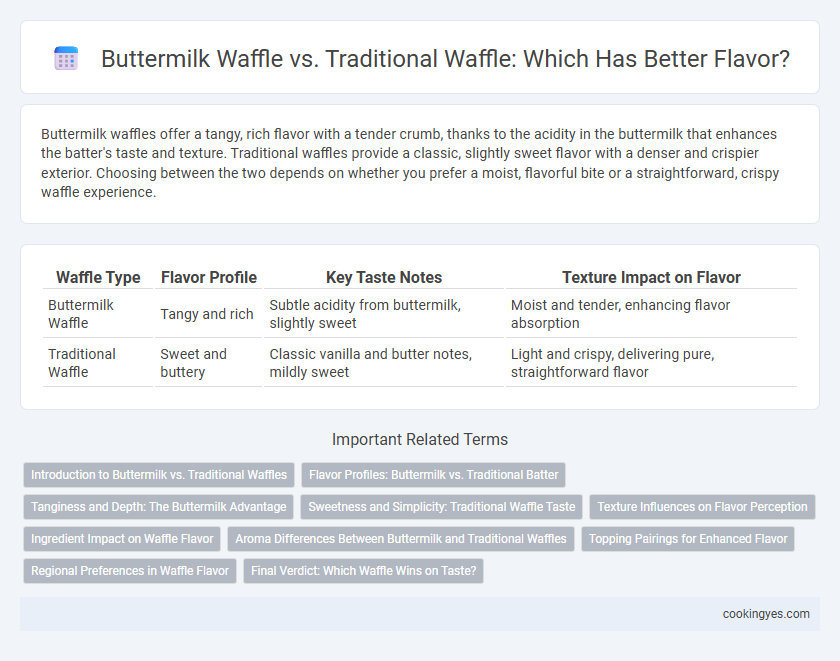Buttermilk waffles offer a tangy, rich flavor with a tender crumb, thanks to the acidity in the buttermilk that enhances the batter's taste and texture. Traditional waffles provide a classic, slightly sweet flavor with a denser and crispier exterior. Choosing between the two depends on whether you prefer a moist, flavorful bite or a straightforward, crispy waffle experience.
Table of Comparison
| Waffle Type | Flavor Profile | Key Taste Notes | Texture Impact on Flavor |
|---|---|---|---|
| Buttermilk Waffle | Tangy and rich | Subtle acidity from buttermilk, slightly sweet | Moist and tender, enhancing flavor absorption |
| Traditional Waffle | Sweet and buttery | Classic vanilla and butter notes, mildly sweet | Light and crispy, delivering pure, straightforward flavor |
Introduction to Buttermilk vs. Traditional Waffles
Buttermilk waffles feature a tangy flavor profile and tender texture due to the acidic buttermilk that reacts with baking soda, creating a light, airy bite. Traditional waffles use regular milk or water, resulting in a milder taste and slightly denser crumb. The choice between buttermilk and traditional waffle batter highlights different flavor experiences, with buttermilk waffles delivering richness and subtle acidity that enhance sweetness and toppings.
Flavor Profiles: Buttermilk vs. Traditional Batter
Buttermilk waffles offer a tangy, rich flavor profile due to the lactic acid in the buttermilk, which enhances the batter's sweetness and provides a subtle acidity that balances the richness. Traditional waffles have a milder taste with a buttery and slightly sweet flavor, relying on simple batter ingredients that emphasize crispness and lightness. The buttermilk variation delivers a more complex and moist texture, while the traditional waffle presents a classic, crisp exterior with a tender interior.
Tanginess and Depth: The Buttermilk Advantage
Buttermilk waffles boast a distinct tanginess derived from lactic acid in the buttermilk, which enhances flavor complexity and puckering sensation absent in traditional waffles. This tang also deepens the overall taste profile, creating a richer, more robust bite that complements sweet or savory toppings. Traditional waffles, made with plain milk, offer a milder, more neutral base lacking the nuanced depth but provide a crisp texture favored for versatility.
Sweetness and Simplicity: Traditional Waffle Taste
Traditional waffles offer a classic, straightforward sweetness that highlights buttery, rich flavors without overpowering complexity. Buttermilk waffles deliver a tangier, slightly richer taste due to the fermented milk, enhancing depth and moisture. For a simple, sweet profile, traditional waffles remain the preferred choice for those who value a clean, familiar flavor.
Texture Influences on Flavor Perception
Buttermilk waffles offer a tender, slightly tangy texture that enhances flavor perception by activating more taste receptors due to their moist crumb. Traditional waffles have a crispier exterior and denser interior, creating a contrast that heightens the sensation of sweetness and buttery notes. The interplay between texture and flavor in buttermilk versus traditional waffles directly influences the overall taste experience, with moisture and crispiness playing key roles.
Ingredient Impact on Waffle Flavor
Buttermilk waffles have a tangy flavor due to lactic acid in the buttermilk, which tenderizes the batter and enhances browning through the Maillard reaction, resulting in a richer, slightly sour taste. Traditional waffles, made with regular milk and sugar, offer a classic sweet and neutral profile with a crisp exterior and light interior. The choice of leavening agents and fat content in both recipes significantly influences texture and flavor intensity, making buttermilk waffles distinctively more complex.
Aroma Differences Between Buttermilk and Traditional Waffles
Buttermilk waffles emit a tangy, slightly sour aroma due to the lactic acid in the buttermilk, enhancing the overall flavor complexity compared to traditional waffles. Traditional waffles offer a sweeter, buttery scent with hints of vanilla, creating a more straightforward, comforting aroma profile. The subtle acidity in buttermilk waffles provides a richer, more nuanced scent that intensifies during cooking.
Topping Pairings for Enhanced Flavor
Buttermilk waffles offer a tangier, richer flavor that pairs exceptionally well with tart fruits like berries and citrus-based syrups, enhancing their natural acidity. Traditional waffles have a neutral, buttery taste that complements classic toppings such as maple syrup, whipped cream, and sweet spreads, balancing sweetness and texture. Choosing buttermilk waffles with tangy toppings or traditional waffles with sweet, creamy additions optimizes flavor profiles for a satisfying breakfast experience.
Regional Preferences in Waffle Flavor
Buttermilk waffles, favored in Southern United States cuisine, offer a tangy flavor and tender crumb that appeals to regional palates seeking a slightly acidic balance. Traditional waffles, commonly found in Northern and Midwestern regions, feature a crispier texture and buttery taste, aligning with preferences for rich, straightforward sweetness. The distinct use of buttermilk versus milk highlights subtle flavor differences that cater to localized regional waffle traditions across America.
Final Verdict: Which Waffle Wins on Taste?
Buttermilk waffles offer a tangy, rich flavor with a tender, moist texture due to the lactic acid in buttermilk enhancing browning and depth. Traditional waffles present a classic, slightly sweet taste with a crisp exterior and fluffy interior that appeals to those preferring a straightforward flavor profile. For flavor enthusiasts seeking complexity and richness, buttermilk waffles win, while traditional waffles satisfy fans of familiar, well-balanced sweetness.
Buttermilk waffle vs Traditional waffle for flavor Infographic

 cookingyes.com
cookingyes.com